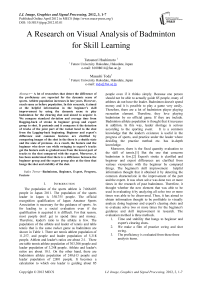A Research on Visual Analysis of Badminton for Skill Learning
Автор: Tatsunori Hashimoto, Masashi Toda
Журнал: International Journal of Image, Graphics and Signal Processing(IJIGSP) @ijigsp
Статья в выпуске: 3 vol.4, 2012 года.
Бесплатный доступ
A lot of researches that detect the difference of the proficiency are reported for the dynamic scene of sports. Athlete population increases in late years. However, coach same as before population. In this research, it aimed at the helpful information in the beginner’s skill improvement by using the dynamic scene to play badminton for the clearing shot and aimed to acquire it. We compare standard deviation and average time from Ragging-back of stroke in beginner group and expert group to shot. It pretends and it compares it the detection of tracks of the joint part of the racket head to the shot from the Lagging-back beginning. Beginner and expert’s difference and common features are clarified by comparing images of the shot in the there is a shuttle state and the state of pretense. As a result, the feature and the beginner who drew yen while swinging to expert’s tracks got the feature such as gradual seen from the lowest part of tracks to the shot compared with the expert. Moreover, it has been understood that there is a difference between the beginner group and the expert group also at the time that hangs the shot and stability of the shot.
Badminton, Beginner, Expert, Progress, Feature
Короткий адрес: https://sciup.org/15012245
IDR: 15012245
Текст научной статьи A Research on Visual Analysis of Badminton for Skill Learning
Published Online April 2012 in MECS DOI: 10.5815/ijigsp.2012.03.01
-
I. Introduction
The population of the sports athlete is 7.666.605 people in Japan 2011. The population of the sports leader in Japan is 358.755 people. The official recognition qualification of Japan Amateur Sports Association is necessary for the guidance of sports. As for leading to a social evaluation even if the qualification is acquired it is difficult. For that reason, most people don't get to spend time and money. Therefore, leader's ratio to the athlete is few. The population of the athlete and leader of tennis and table tennis that is the same racket game as badminton are shown in Table 1. There are tennis athlete population of 11,257, and people and leader population of 5,318 people. Athlete and leader's ratios are about 2:1. There are table tennis athlete population of 303,306 people and leader population of 3,248 people. Athlete and leader's ratios are about 10:1. On the other hand, there are badminton athlete population of 240,613 people and leader population of 2,801 people. It becomes a calculation to which one leader is guiding about 85
people even if it thinks simply. Because one person should not be able to actually guide 85 people, many of athletes do not have the leader. Badminton doesn't spend money and it is possible to play a game very easily. Therefore, there are a lot of badminton player playing recreation element. Therefore, they love playing badminton by no official game. If they are include. Badminton athlete population is thought that it increases in addition. In this way, leader shortage is serious according to the sporting event. It is a common knowledge that the leader's existence is useful in the progress of sports, and practice under the leader where deciding the practice method etc. has in-depth knowledge.
-
1. Time and stability that hangs to beginner and expert's clearing shots.
-
2. We make a film of practice swing and shot swing.
-
3. The proficiency is evaluated from these three analysis items.
Table.1 The population of the sports athlete and sports leader in
Japan
|
Sports |
Athlete population |
Leader population |
|
All sports |
7,666,605 |
358,755 |
|
Tennis |
11,257 |
5,318 |
|
Table tennis |
303,306 |
3,248 |
|
Badminton |
240,613 |
2,801 |
-
II. METHOD
When it is the most suitable stroke for seeing beginner and expert's differences because it is operation that various elements necessary for badminton are demanded though clearing shot is a basic stroke in this research, the idea clearing shot operation is targeted. Moreover, similar can be said even if it sees from respect where data is collected because it is difficult for the beginner to strike intending it in other strokes and to divide. Clearing shot is a stroke with long flight duration that draws an interior from the interior of the court to the other party court and a high parabola and flies.
Solve of two or more times was done in experiment 1, and time was measured from the Raging-back beginning to the shot that is beginning of the swing. Raging-back is operation to which the racket is pulled by using the wrist, and this operation is a beginning point of the swing operation. When beginning to Raging-back it, it judges it by watching. It took a picture made of CASIO EX-FH100 420 scenes per second by setting up a high-speed camera to visually analyze this.
-
A. Visibility criteria of start Ragingback
Beginning the Raging-back in this research was judged from watching. The visual check standard is described in this paragraph, because the racket is pulled by characterizing and using the wrist of Raging-back, dorsiflexion movement. Therefore, a small amount of making of becoming it change happens in the angle of respect of the racket head according to the dorsal flexion of the wrist and the racket shaft when animation is observed from the tester side. Concretely, rackets shorten more before it begins to Raging-back it of the length of the shaft in view of the camera. Moreover, a thing similar as for the racket head can be said. It was judged to assume these to be a visual check standard and to begin Raging-back. Figure 1 shows before that it begins to Raging-back. Figure 2 shows that it begins to Raging-back.
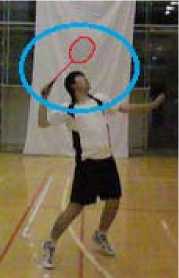
Figure 1. Before begin to Raging-back

Figure 2. Begin to Raging-back
-
B. Visibility criteria of clearing shot
It judged it from watching the angle in the shaft of the racket of the shot of pretense to compare images when the shuttle was actually done the shot in this research as the image when pretending. The image of the shot was pulled out from the image that actually struck the shuttle when the image of the shot was judged from watching, and it referred to the angle in respect with the shaft of the racket. Moreover, the tendency in front of two frames was seen from the becoming it frame angled in the shaft of the racket at the shot and vertical with ground the image that actually struck the shuttle. The image of the shot was pulled out from the image of pretense based on the above mentioned two points. Figure 3 is a shaft of the racket to which it refers when judged from watching and an angle in respect.

Figure 3.Clearing shot when the angle of the racket
-
III. EXPERIMENT 1
The experiment held in the Future University Hakodate gym. The table 2 shows experimental conditions and the use machine parts. Testers are 15 people.9 people are six years or more of the game experience. This was made an expert. It is opposite and for the beginner, six people are game experience is less than three years. All members are right-handed. The division of this beginner and expert is the one having put it when the actual experiment is done. Expert nine people H, I, J, K, L, M, N, O, P. Three beginner girls are Q, R, S, and three beginner boys are T, U, V. The number of scenes from the Raging-back beginning to the shot was counted by using the animation of which it took a picture and time was calculated. The beginning operation of Raging-back was made to time where the racket head began to move from the Take-back completion position to the left side of tester's body, and decided by watching. Figure 4 shows author judged Raging-back starts. Figure 5 shows author judged tester shooting shuttle.
Table 2. experiment environment and condition 1
|
Tester |
15 |
|
Number of trials |
10 |
|
Expert man |
H, I, J, K, L, M, N, O, P |
|
Beginner girl |
Q, R, S |
|
Beginner man |
T, U, V |
|
Racket |
YONEX ARCSABER Z-SLASH |
|
Shuttle |
YONEX F-50 high clear 4 |
|
Camera |
CASIO EX-FH100 420fps |
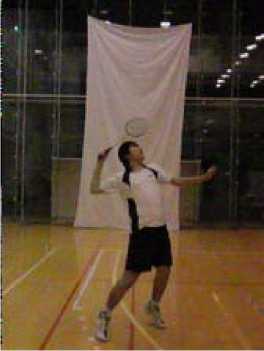
Figure 4. Raging-back starts

Figure 5. Tester shooting shuttle
A. Experiment environment
Figure B concrete experimental environment is shown and the experiment procedure is shown in figure C below.
-
1. The experimenter shot out the shuttle to B.
-
2. The tester moves from A to B along with shoot out the shuttle along of experimenter.
-
3. The clearing shot to the testee according to the fall of the shuttle for a right back hand from B.
-
4. The testee returns to A after the clearing shot ends.
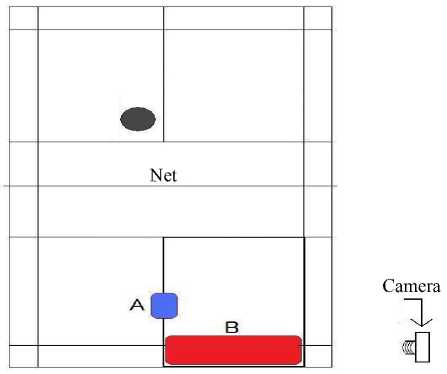
Figure 6. Experiment environment 1
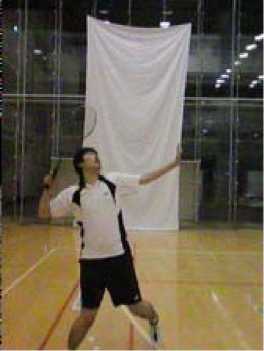
Figure 7. Experiment scene 1
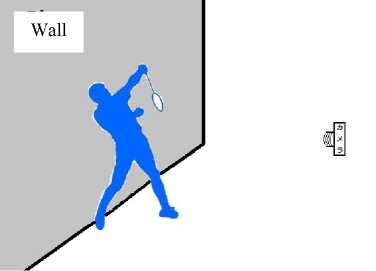
Figure 8. Experiment environment
-
IV. EXPERIMENT 2
-
A. Experiment environment 2
Experiment 2 held in the Future University Hakodate gym. All testers of experiment 2 are righthanded by six people. Three expert boys are assumed N, X, Y, and beginner girl are assumed S, and two beginner boys are assumed T, U. Moreover, experimental conditions and the use machine parts are shown in table 3. The tester arranged it so that the side of the one's dominant arm might come in front of the camera as shown in figure C. A concrete experimental environment is shown and the experiment procedure is shown in figure B below.
-
1. Pretense that the tester considered the clearing shot is done.
-
2. After the following swing ends, vertical posture is taken.
It went above by each of five trials as one one person trial. Figure B is the one having taken a picture by an actual experiment.
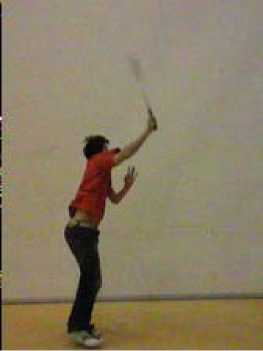
Figure 9. Experiment scene 2
Table 3. experiment environment and condition 2
|
Tester |
6 |
|
Number of trials |
5 |
|
Expert man |
N, X, Y |
|
Beginner girl |
S |
|
Beginner man |
T, U |
|
Racket |
YONEX ARCSABER Z-SLASH |
|
Shuttle |
YONEX F-50 high clear 4 |
|
Camera |
CASIO EX-FH100 420fps |
-
V. experimental result 1
The beginner and expert shows in table 4 and table 5 at time from the Raging-back beginning judged from watching to the shot. Moreover, time from the expert group and the beginner group Raging-back beginning to the shot is indicated in table 6.
Table 4. Time from the Raging-back beginning to the shot in Expert
|
Tester |
Standard variation |
Average time |
|
H |
0.0305 |
0.3341 |
|
I |
0.0144 |
0.2764 |
|
J |
0.0318 |
0.2671 |
|
K |
0.0115 |
0.2579 |
|
L |
0.0192 |
0.2443 |
|
M |
0.0185 |
0.2736 |
|
N |
0.0143 |
0.2664 |
|
O |
0.0139 |
0.2605 |
|
P |
0.0389 |
0.3955 |
Table 5. Time from the Raging-back beginning to the shot in beginner
|
Tester |
Standard variation |
Average time |
|
Q |
0.0438 |
0.3488 |
|
R |
0.0876 |
0.4533 |
|
S |
0.0664 |
0.4998 |
|
T |
0.0423 |
0.2760 |
|
U |
0.0367 |
0.3217 |
|
V |
0.0613 |
0.3060 |
Table 6. Time from the Raging-back beginning to the shot in expert cohort and beginner cohort
|
Tester |
Standard variation |
Average time |
|
Expert cohort |
0.0214 |
0.2862 |
|
Beginner cohort |
0.0563 |
0.3676 |
-
A. Standard variation make a comparison between expert cohort and beginner cohor time from the Raging-back beginning to shot
It paid attention at the standard variation of time from the Raging-back beginning the expert group and the beginner group to the shot, and the beginner group to the shot compared with the expert group set up the hypothesis that the expert reproducibility of the shot is high. It gave official approval to the standard variation of time from the Raging-back beginning the expert group and the beginner group to the shot as the verification.
F was given to official approval to confirm the standard variation of time from the Raging-back beginning the expert group and the beginner group that had obtained it from experiment 1 referring to table A-B to the shot was a capitation scatter in the expert group and the beginner group in the beginning. As a result, it becomes F=3.61, F α =3.69, and 1 ≦ F ≦ \F α , and it becomes P>0.05. Therefore, it was obtained that it was a scatter in a word of being not able null hypothesis H0 dismissal of capitation.
Next, the average of the standard variation of time from the Raging-back beginning the expert group and the beginner group to the shot confirmed there was a difference between the expert group and the beginner group by using T authorization. It becomes t>tα at the significance level 5% because it is tα=2.160 of the significance level 1%, and it becomes P<α result t=-5.075 and tα=3.012 at the significance level 1%. Therefore, the null hypothesis is dismissed. The result it was found that the expert group that the expert reproducibility of the shot is high. Moreover, the danger rate judged that there is a significant difference is originally 0.000432 in this data though there is no significant difference.
-
B. Average time make a comparison between expert cohort and beginner cohor time from the Raging-back beginning to shot
It paid attention at the average time of time from the Raging-back beginning the expert group and the beginner group to the shot, and time that the expert group hangs to the shot compared with the beginner group set up the hypothesis that the beginner became long. It gave official approval to the average time of time from the Raging-back beginning the expert group and the beginner group to the shot as the verification.
F was given to official approval to confirm the average time of time from the Raging-back beginning the expert group and the beginner group that had obtained it from experiment 1 referring to table A-B to the shot was a capitation scatter in the expert group and the beginner group in the beginning. As a result, it becomes F=3.21, F α =3.69, and 1 ≦ F ≦ \F α , and it becomes P>0.05. Therefore, it was obtained that it was a scatter in a word of being not able null hypothesis H0 dismissal of capitation.
Next, the average of the average time of time from the Raging-back beginning the expert group and the beginner group to the shot confirmed there was a difference between the expert group and the beginner group by using T authorization. It becomes t>tα at the significance level 5% because it is tα=3.012 of the significance level 1%, and it becomes P<α result t=-2.507 and tα=2.160 at the significance level 5%. Therefore, the null hypothesis is dismissed. The result that time that the beginner group to the shot than the expert group was intentionally long was obtained. Moreover, the danger rate judged that there is a significant difference is originally 0.038 in this data though there is no significant difference
-
VI. experimental result 2
The frame at the shot was pulled out from the animation of which it took a picture by experiment 1 to compare images of the shot. Figure 10-15 shows the image of the shot of obtaining from image and experiment 2 of the shot of obtaining from experiment 1.
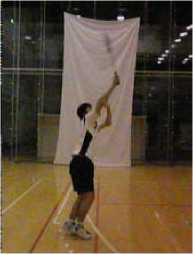
Figure 10. We make a film of shot swing in expert N experiment 1.

Figure 14. We make a film of shot swing in beginner S experiment 1.
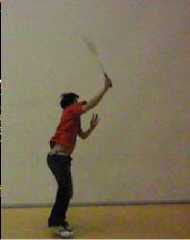
Figure 11. We make a film of practice swing in expert N experiment 2.
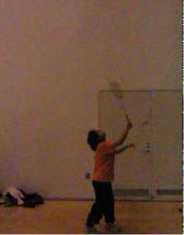
Figure 15. We make a film of practice swing in beginner S experiment 2.
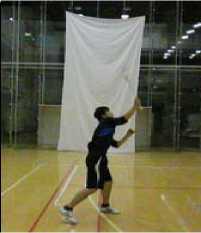
Figure 12. We make a film of shot swing in beginner Q experiment 1.
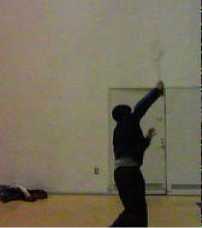
Figure 13. We make a film of practice swing in beginner Q experiment 2.
-
VII. consideration
-
A. Standard deviation of up to shot
It has been understood that there is a difference in the standard deviation at time from the Raging-back beginning to the shot that is beginning of the swing in the expert group and the beginner group because of authorization to the result of experiment 1. The standard deviation of the beginner group at time from the Raging-back beginning to the shot is larger than that of the expert group. It is thought that the shot cannot be stricken with stability when the standard deviation (with rose) at time from the Raging-back beginning to the shot that is beginning of the swing is large. In a word, the reproducibility of the shot is low. It is thought that comparing the standard deviation at time from the Raging-back beginning to the shot because a significant difference was seen between the expert group and the beginner group becomes an effective index to evaluate the proficiency. Only the analysis of single solve is done in the research on past badminton the reproducibility of the shot becomes a big index to evaluate the proficiency. Therefore, two or more solve is done like this research and this index that came out in the all for the analysis becomes a new index.
-
B. Average time of up to shot
Moreover, it has been understood that the beginner group is more significant and longer than the expert group since averages of time from the Raging-back beginning to the shot are compared in the expert group and the beginner group. Therefore, the time takes when the beginner strikes the clearing shot is long. Moreover, the change was seen from Tanaka's research in the angle of the racket shaft as for the form of beginner and expert's clearing shots though there was no difference with significant speed of the racket.[3] The beginner is longer at the time that hangs to the shot though the change is not seen at the speed at which the racket is shaken among the expert and beginners. As for this, tracks of the swing that shakes the racket are thought for the difference to exist between the expert and the beginner.
-
C. Experiment 2
Images of the shot of figure 10-15 experiment 1 and experiment 2 are compared. Focus on the arm of the subjects. It experiment 1 to expert's arm. It expands straight by both of experiment 2. However, beginner's arm is curved in experiment 1 that actually strikes the shuttle. In experiment 2 on pretense to consider the clearing shot, the arm has expanded straight. Moreover, even if the shot position is compared with experiment 1, the shot can be done at a place far from the body and a high position. Whether the beginner cannot do the shot to my shuttle and the distance feeling to the racket at a position away from the body with a stretch of the arm because he or she is not accurate is thought.
-
VIII. CONCLUSION
Список литературы A Research on Visual Analysis of Badminton for Skill Learning
- Toshio Asano, Tomoyuki Yoshida, and Kazuo Tamano, “Quantitative evaluation of tennis skills by computer vision”, Journal of the Japan Society for Precision Engineering, 70(9), pp.1169-1173, 2004-09-05 (in Japanese).
- Takahiro Okabe, Tadaaki Bandoh, and Kahoru Nakayashikii, “Badminton Practice System Using Image Processing Technology”, Proc. Of The 72nd National Convention of IPSJ, Vol. 2, pp. 735-736, 2010.03 (in Japanese).
- Masanori Tanaka, “Analysis of CLEAR Action in Badminton”,http://adlib.rsch.tuis.ac.jp/~akira/bunka/summary2006/html/ishii/C03103.pdf, 2006.

